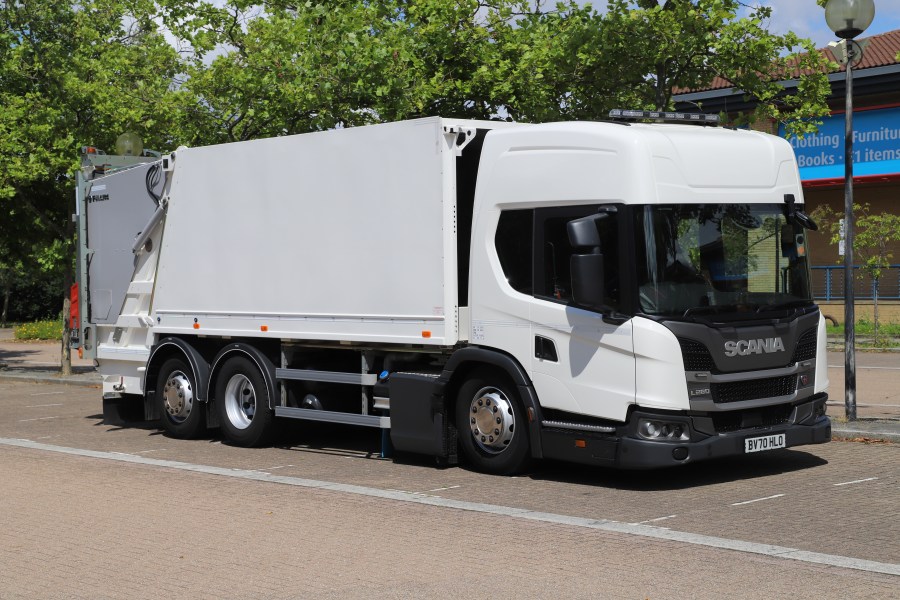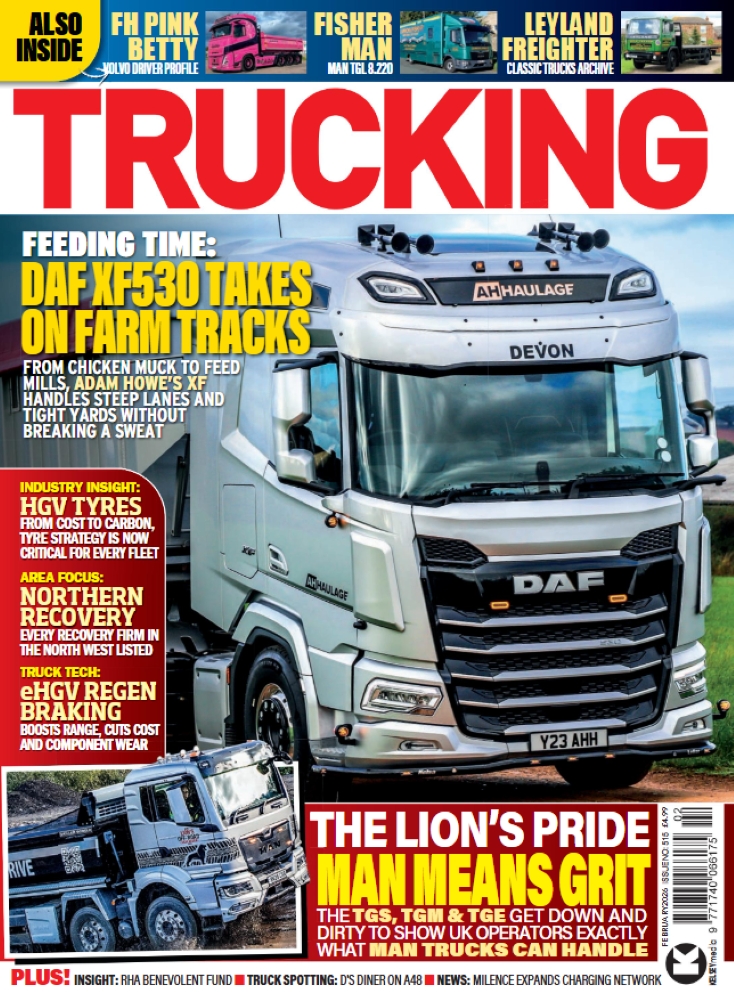There are more low-entry trucks being registered than ever before and they make sense for many applications – not least, bin lorries. We take a Scania L280 wagon out for a drive to see if it’s good or a load of old rubbish…
If you drive a bin lorry, chances are you are more interested in your pay packet and getting home of an evening that being a “it’s in my blood” type of truck driver. And it might follow, then, that you are probably not all that bothered how your truck looks.
The aesthetic of a low-entry truck can niggle some drivers, but they might well get to love it after they’ve spent a day repeatedly climbing into and out of the cab and found just how much easier it is compared to a taller cab.
For inner-city deliveries and refuse collection, where drivers and crew are in and out of the truck all day, low-entry trucks are ideal. Payload isn’t usually a key factor, but driver welfare is – so having a single-step, low-height cab is perfect.
Furthermore, these trucks naturally work in urban areas where there are lots of risks – pedestrians, elderly people, dog-walkers, school children, cyclists and people on mobility scooters – the list goes on. With that in mind, a driving position closer to the eye-level of passers-by can aid visibility.
Low-entry: Nothing new
For bin lorries, low-entry cabs have been a common thing for many years – in fact, Scania even had a low-entry 86 model in the 1970s! ERF and Seddon Atkinson both had low-entry trucks for refuse applications in the 1980s and 1990s; and of course, Dennis has been building them for years.
But now low-entry cabs are being seen as useful for many other applications aside from rubbish trucks, and in that respect Scania’s L-series has a lot going for it. For example, Fagan & Whalley (featured in the February 2022 issue) has taken on a 4×2 L280 as a curtainsider to evaluate its effectiveness for town deliveries.
Rose Group (featured in the April 2022 issue) has a 6×2 L360 for delivering building materials to domestic customers. In both cases, the purchase has been to make life easier for the driver, who is expected to be in and out of the cab many times during their working day.
Other uses of the L-series have been scaffolding trucks, tippers, utility support vehicles and fridge vans for inner-city deliveries. They will undoubtedly be popular for line painting and highways maintenance. And because Scania works on a modular system, you can have an L as a 4×2 tractor, which is useful for any job where town driving is the majority, or where multiple trailer swaps are likely. For rigids, you can have an L-series as a 4×2, 6×2, 6×4 and 8×2 or 8×4 tridem.
The L-series is based on Scania’s smallest P-series sleeper cab, which has been moved forward and lowered, meaning the engine hump is behind the seats. Although the cab is the same as the P, it’s not a sleeper – which, given the work these trucks do, is arguably not an issue.
There are three cab heights, with the high roof favoured as it gives more room for standing up when entering. But you can also have a standard height or a flat-roof version. There is room for four seats in the cab, which is vital for dust-cart applications.
Technical overview
The L-series is available with two engine sizes: 7- and 9-litres. The former is six-cylinders and available at 220, 250 and 280 bhp, while the latter five-cylinder is available in 280, 320 and 360 bhp outputs – so there’s a nice overlap. The cab is too low to accommodate the 13-litre straight-six, which means 360 bhp is the most powerful option.
While that choice is adequate for most operators, some who want a 6×2 or eight-wheel options may prefer a bit more power. However, given these trucks are not likely to be doing much long-distance mileage, 360 bhp will be fine even as an 32-tonne eight-legger.
As an aside, the 280 bhp as a 9-litre has a bit more torque – 1400 Nm, as opposed to 1200 Nm in the six-cylinder, 7-litre engine. There are gas options on the 9-litre (at 280 and 340 bhp), but not on the 7-litre. The 9-litre can also run on biodiesel and HVO, while the 7-litre is limited to just HVO as an alternative.
The truck on test here is the smaller DC07-113 D01 engine rated at 280 bhp – so the top output for the smaller engine. The transmission on our truck is the GRS905 12-speed Opticruise automated ’box, the same you’d find on many other off-the-shelf Scanias. The front axle is rated at 8000 kg, the drive axle at 11,500 kg and the rear steer tag axle at 7500 kg. The wheelbase is 3950 mm. The rear axle ratio is 1:2.92.
Despite being a low-height vehicle, the wheels are still 22.5 inch steel and the tyres are 315/70R22.5.
On the road
Having said the L-series is not just a bin wagon, the test vehicle we had from Scania was just that – fitted with a refuse collector and compactor body. The reality is it could have had any body and it wouldn’t have made a difference for our evaluation. That said, it did mean the truck was unladen – although it was carrying a few extra tonnes in weight because of that bin body.
Despite its intended role as a day truck, the cab still oozes Scania quality. There has been no drop in the features nor the build; the inside is still superbly appointed and a lovely place to work. Of course, bin work is not necessarily the cleanest of jobs, so some might find the cloth seats get dirty quite quickly.
The engine hump at the back is a bit intrusive, but you soon forget it’s there. On the road, the L280 handles very well indeed and is as enjoyable to drive as a P- or G-series. Its steering is light and precise, and the steering wheel has many of the buttons you’d expect to see on any other New Gen model. Once you get used to the front overhang, it’s actually very manoeuvrable and the rear steering is a definite boon for a truck like this.
We took it for a relatively short spin around Milton Keynes and not just on the roads themselves, as we called in at the station for some ‘tight-manoeuvre driving’. The fact we also got a sandwich here was entirely coincidental.
With a mass of bollards, kerbs, bins, a bus shelter and lots of people (many of them not really looking where they were going), it was indeed a relatively tight place to drive a truck. But it was still very easy to get the L in, park it and then get it out again.
Kneeling down
A great feature of the L-series is its kneeling function, where you can lower the cab so the step is almost at ground level. We can’t help thinking your average dustman won’t bother using this function too often as it takes too much time, and the cab is already very low regardless – but it’s still a useful feature.
The truck was unladen, but 280 bhp for a 26-tonner is more than enough power, especially if the vehicle is spending a lot of its time in stop-start fashion. But if you do want more grunt, then as mentioned, there’s more choice – and indeed Veolia has L320 dustcarts in its fleet.
The L-series certainly looks a bit chunky and borderline ungainly, especially with the high-roof cab. The headlights don’t help in that respect, and in plain white it looks a bit boring. A nice livery will help spice things up; but remember, this is a functional truck and is unlikely to win any awards at shows.
Of course, one of the big plus points of an L-series of the forward visibility, which is superb, as you might expect. Being so low down certainly helps in town driving, and with a lower window in the passenger door, it affords even more visibility for the driver.
There is ample overhead storage. Remember: you might have a crew of four in this, all wanting to store their lunchboxes and any other stuff they might need for their daily work, so the generous lockers are a real bonus.
The dash is the same as any New Gen Scania, which means it’s functional, useful, clear and easy to use. Rear vision is good as you’d expect from Scania’s mirrors; but this truck could really benefit from cameras instead of wing mirrors. Currently, Scania is developing digital mirrors for its heavy trucks and we are led to believe they will be offered across its entire range in due course – including the L-series, where we think they’ll prove especially useful.
Verdict
You really can’t do an appraisal of an L-series without drawing the obvious comparisons with its competitors. It’s up against the Mercedes-Benz Econic, but we reckon the German looks a bit utilitarian and basic inside, and its bus-style folding doors don’t do it any favours.
That said, bus-style doors are an option for the L-series – they have the advantage that they don’t open out into pavements and you can even drive with them open, but they look pretty ghastly. But again, functionality over looks is a key thing for this kind of truck!
The Scania has more driveline options than its German rival, and it’s certainly more modern. The dash is better, the seats are better and the whole ambience of the cab is more comfortable. It feels more like a ‘real’ truck, if that make sense.
But the L is not just going up against the Econic. Volvo, Renault and Dennis Eagle all have low-entry cabs, so Scania has its work cut out to make sure the L is a winner. The truth is it’s a very good truck, and so we’ve no doubt a host of county councils and private refuse collection companies will be looking at it – though it has great potential for a host of applications.
It’s worth mentioning that driver perception is not an overly big issue. Any professional driver worth their licence will take to an L if it’s the best tool for their job. If you need a low-entry truck, the Scania L-series is certainly one of the best.
We like
+ Superb cab interior
+ Manoeuvrable
+ Great forward vision
+ Good engine options
+ Drives well
We don’t like
– It’s certainly not a looker!
– Digital mirrors needed






